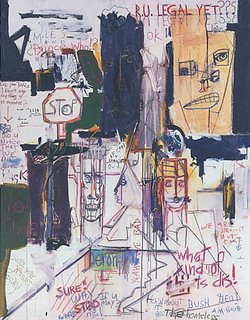Welcome to my porn site.
I started writing on art on the heels of the ’93
Tit for Tat
Whitney Biennial 2006: Day for Night
Whitney Museum of American Art,
Closed
 Someone called it the Post-America Biennial. It would be better to call it the Post-Traumatic Post-Op TransAmerica Biennial. That would be more like it. There is no Post-America.
Someone called it the Post-America Biennial. It would be better to call it the Post-Traumatic Post-Op TransAmerica Biennial. That would be more like it. There is no Post-America.
Any pretense of art world globalization principally centers on an extended jet set of art professionals and collectors; all the work and the people are essentially the same—it is a traveling show that has the gesture of universality with none of the bitter aftertaste. Although jet-setting is far more accessible than it once was, insofar as I am tethered to this bedrock, I prefer the notion of grasping the global through the local. As the Senator from
Now that the notion of a themed biennial has been introduced, I’d like to propose a few of my own:
1) The Hierarchical Biennial: The Bucksbaum Award is a start, but I want a real judged show in which the exhibiting artists are pitted against each other in various hard and soft categories. Prizes are awarded by jury and, hold your nose here, the public!
2) Video-Free Biennial: Why not? We’ve already had painting-free biennials.
3) All Local/All World Biennial: Artists who come from somewhere: live/work in the Metro-area,
4) All Women Biennial: Isn’t about time? Besides, then we wouldn’t have to hear about the dearth of women artists in the Biennial until the following Biennial.
5) All People of Color Biennial: Ditto. [Except no fair recycling the usual suspects. There are other people of color in the world besides those
As for this one….
My favorite professor of gallery administration stresses that if you are going to curate a themed exhibition, you should shape your theme to the works and not vice versa. Ok, so right away they fucked that up.
The 4th floor played the theme day for night as black for white [and gray]. The first space off the elevator featured Uri Fischer’s busted room, The Inelligence of Flowers, which contains another piece of his, Untitled (branches), an inexorable aluminum slowly rotating and dripping wax and a large b&w painting by Rudolf Stingl, Untitled (After Sam) [what’s with all these untitled pieces having titles?]. Together the works make for a handsome gallery—something that might work well as a
The 3rd floor seemed to interpret day for night as good for bad. Individual artists were called on to show their best and the worst pieces respectively.
The second floor seemed to play out day for night as good for bad behavior with Billy Sullivan’s slide show leading the way displaying the now seemingly innocent [good] bad behavior of yesteryear [70s etc.] Although
Otherwise, other trends stumbled along. Along the female photographer front, let us hope and pray that
Finally, it was amazing, but in all honesty there were no videos worth dallying over except Light did a lovely job evoking the long shadow that
In the spirit of resurrecting defunct notions of good and bad [or in the hopes of being Duchampian], I give u RU Legal? by
* * *
Inka Dinka Don’t
303 Gallery,
http://www.303gallery.com/
Closed
For a long time I’ve resisted judgment on Essenheigh [or at least judging Inka from on high]. I’ve also resisted making any references to
These recent paintings are straight assembly line canard. Each canvas is coated uniformly in its own tasteful background color right around the edges. Images are painted on top generally from dark to light building up imagery straight out of the computer-generated playbook—there may even be a shortcut for these particular distortions: oddish tableaus of figures in situ melting, drooping or swooping into and through each other to no particular end. These things aren’t even as fun to look at as most of Essenhiegh’s earlier extreme abstractions. Kudos to the curatorial machinations behind this show though. The least of the works Inka crinked out is hung alone in the back room beneath a fabulous skylight. By showcasing the thinnest and most under-painted [and not good under-painted] work in the exhibition, the gallery tries to spit shine the turd and pass it off as gold. A gutsy gambit but we’re not buying.
* * *
Lucky DeBellevue
Feature Inc,
featureinc@feautreinc.com
Closed
First of all his name is too good. Second of all they’re pipe cleaners not chenille stems…ugh. In spite of that and in spite of never really being terribly moved by the work—I am moved by the work. These simple sculptures each humbly and movingly play on the nature of the support; the pieces literally and heartbreakingly address one of the fundamental issues of sculpture by replacing classic armatures with canes, crutches and showers stools. In one piece, Cuirass, three clear minibike half-torso shields surround a green chenille blob of a drooping heart. Though less about support than protection, Cuirass reveals the vulnerability at the soft center of DeBellevue’s work. His pieces, barely able to stand up for themselves, nevertheless manage to do just that with the help of the artist’s strong and loving embrace.
For this exhibition, the gallery’s usual policy of group shows only [except for
Life is short.
artholes!
We love this site, we love you. S&L
ReplyDelete